Read the Dutch version below
[We] begin to expand that archive with the aim of ensuring that it will no longer be what it was,” says artist/photographer Andrea Stultiens about the impressive exhibition and publication in which, in collaboration with numerous African creatives, the work of colonial photographer and anthropologist Paul Julien is re-viewed.
It began with the discovery of one of Paul Julien's books at a second-hand market. Images of a trip through an African country. One of the pictures showed the porters of his luggage. Who were these porters? What were their names? How did they experience this trip? How did they view the white anthropologist they accompanied? All these questions led artist and photographer Andrea Stultiens into the oeuvre of a man who helped spread a romantic and exoticized view of Africa. There are no clear answers to these questions but, together with a number of African colleagues, Stultiens manages to penetrate what can be called a jungle of bias.
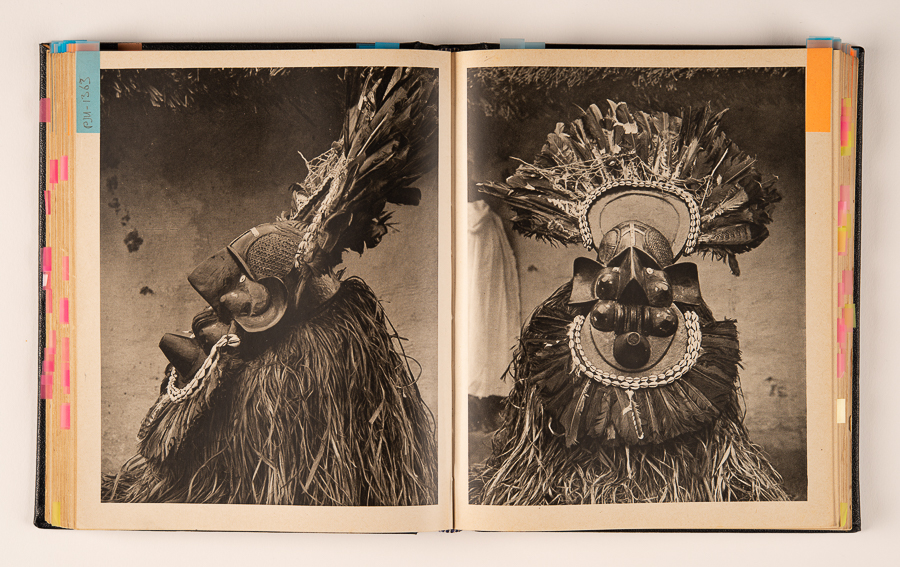
Negbema, Sierra Leone, 1934 - 1946.
Special edition of the book ‘Campfires Along the Equator’. Photographs of “The Jaye Devil of the Mende, Sierra Leone”, produced by Paul Julien. Reproductions and digital collage Andrea Stultiens.
The Dutch amateur anthropologist and photographer Paul Julien (1901 - 2001) visited Africa between 1932 and 1962. He reported on his travels in well-attended lectures illustrated with lantern slides and silent films, much-lauded radio talks, and widely read books and articles. Julien's depictions should perhaps primarily be seen as an expression of how “Africa" was thought of in the Netherlands and in the West at the time. His work had a profound influence on a Western, Eurocentric imagination of a “dark continent”, perceptions that have descended into the collective consciousness. It was, in his words, the irresistible “call of the jungle” that made him travel to countries like Sierra Leone, Uganda, Congo, Kenya, Liberia, Sudan, and Ethiopia. His work introduced the Western public to time-frozen “tribes,” exotic creatures characterised as that vicious concept, the other, with the pygmy endlessly researched by Julien as a pars pro toto.
Julien's depictions should perhaps primarily be seen as an expression of how “Africa" was thought of in the Netherlands and in the West at the time
Julien was actually a mathematician and chemist, but soon applied himself to what was then called “physical anthropology,” the study of biological differences that, in the opinion of leading Enlightenment thinkers (Locke, Kant, Voltaire, and others), justified a racist ranking of people. In that view, black people were inferior. Julien researched blood groups during his travels and did not shy away from measuring a skull from time to time. Once, he brought the skeleton of a young woman from the Congo to the University of Utrecht for further examination.
Julien benefitted from all the conveniences afforded to a privileged traveller. He was a white man who travelled on a diplomatic passport, and nowhere felt obliged to ask his “subjects” for permission. He gained access to people and territories with written recommendations from colonial authorities. He shamelessly shopped the work of others and “borrowed” what helped him further colour his stories, preferably without citing sources. He presented his trophies as a personal discovery. A contemporary scholar characterises Julien’s approach as veni vidi vici – he came, he saw, and he conquered.
A contemporary scholar characterises Julien’s approach as veni vidi vici – he came, he saw, and he conquered
One could, for good reasons, condemn Julien's oeuvre to the dung heap of colonial history and argue for removal from the collections of the Nederlands Fotomuseum (Rotterdam) and the Eye Filmmuseum (Amsterdam) in which it is stored. But, according to artist and photographer Andrea Stultiens, that would be a somewhat facile approach. She does not hesitate to condemn Julien's methodology as an expression of “cultural violence” and his approach to African people as “invasive.” She is not surprised that Julien's missions in Africa ended rather abruptly in 1962. He shifted his attention to Asia because he could not continue to browse in a post-colonial Africa unhindered by post-colonial governments.
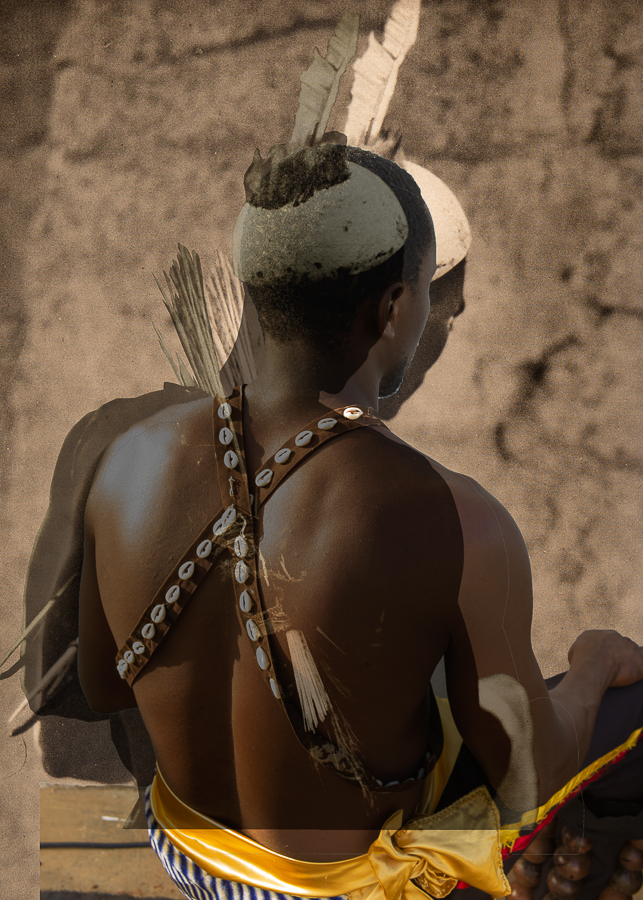
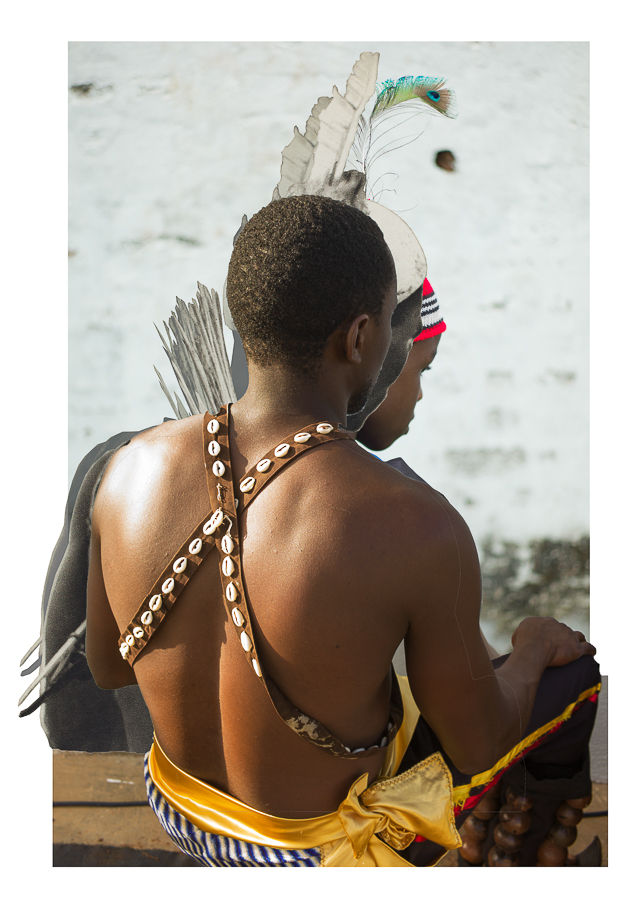
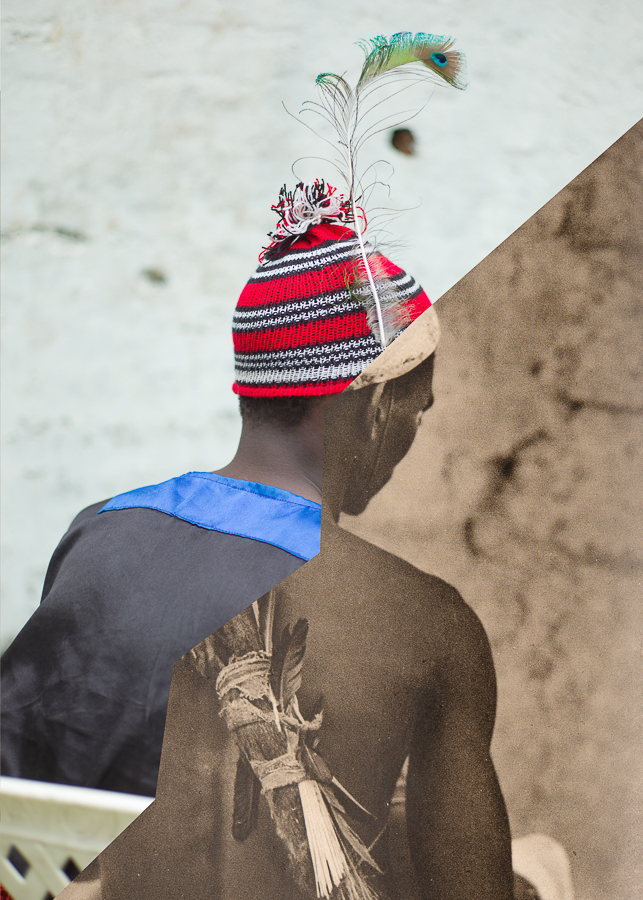
Digital collage based on photographs produced by Paul Julien in 1935 and by Andrea Stultiens in 2015with a musician of ‘Kika Troupe’ from Uganda.
Collage, Andrea Stultiens.
Digital collage based on photographs produced by Paul Julien in 1935 and by Andrea Stultiens in 2013 / 2015 with a dancer of ‘Footprints of David’ from Nigeria, and a musician of ‘Kika Troupe’ from Uganda. Collage, Andrea Stultiens.
Digital collage based on photographs made by Paul Julien in 1935 with a man in Upper Volta, and by Andrea Stultiens in 2013 with a performer of cultural troupe ‘Footprints of David’ in Nigeria.
Collage, Andrea Stultiens.
But should he be cancelled? No. Stultiens thinks she wouldn't have liked Paul Julien but, at the same time, she is happy and grateful to be able to work with his photographic legacy. That is what she is doing: working with it, adding, in the words of the director of the Nederlands Fotomuseum Birgit Donker, a “radical nuance”. Inspired for instance by the anthropologist Paul Basu’s “Re-Entanglements,” Gloria Oyarzabal's “Picnos Tshombe,” and the work of Congolese artist Sammy Baloji, Stultiens sought collaboration with African researchers, artists, and curators over the past twelve years, with the goal of bringing nuance to Julien's images and texts. The result is an impressive publication and the reflection of her research in what is both a laboratory and an exhibition at the Nederlands Fotomuseum, titled “I wish there was colour, I wish there was sound.” The title is taken from a quote by Sierra Leonean scientist Arthur Abraham, who looked at Julien's work not long before his death in 2020.
Colour and sound is exactly what Stultiens adds
Colour and sound is exactly what Stultiens adds. A considerably richer imagination emerges that no doubt does more justice to the world we see. It is an irony that, in the end, this corrupted work of Julien produces so much beauty. For this we should be grateful to the children who coloured in Julien's work with crayons and markers. Also wonderfully articulated is the imaginative hike poet and photographer Kemurl Fofanah takes to the top of Mount Kunon, “a staircase to God”, based on Julien's much concealing texts and images. There is some appreciation in Fofanah's assessment of Julien's work, but he also reads it as “all too jerky, so much like a mixture of imagination, subjective reality and, the all-too-common cliché of the ‘civilized westerners’ meeting the ‘uncivilized Africans’.” Esther Kamara, for her part, puts herself in the Bundu girls photographed by Julien, and writes the story from their perspective. With a disclaimer: “Allow us to be critical of the teller. All I can give you – ever – is fiction.” Artist Abu Kanu creates new masks in response to Julien's photographs of the Njaye people, as printed in the bestseller, Campfires along the equator.
Equally enchanting are Stultiens' own collages, in which images of a current reality, and sometimes colour, overlay or intervene in the old. “All in all, a project emerges that can act as a complementary example of good practice, an alternative to the, in my view all too easy, cancelling of material that stems from problematic, painful, violent practices of the past,” Stultiens says.
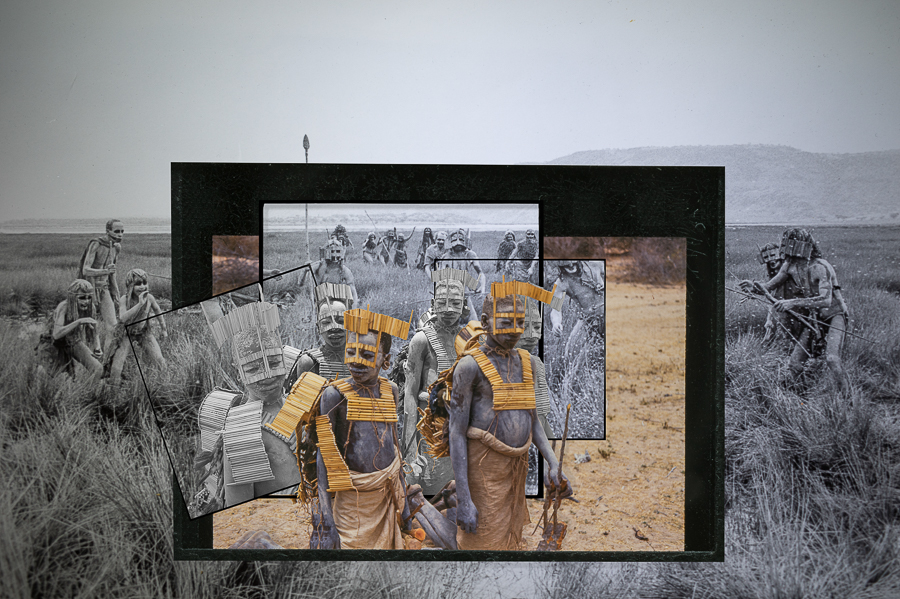
Collage, Andrea Stultiens.
With texts that avoid any academic jargon, Stultiens brings Julien's work to life. To real life.
The book I wish there was colour, I wish there was sound is available at the exhibition at the Nederlands Fotomuseum in Rotterdam. Still until September 15. The book can also be ordered from bookstores.
–
“We maken een begin met het uitbreiden van het Archief met de bedoeling ervoor te zorgen dat het niet langer zal zijn wat het was”, zegt kunstenaar/fotograaf Andrea Stultiens over de indrukwekkende expositie en publicatie waarin samen met tal van Afrikaanse creatieven het werk van de koloniale fotograaf en antropoloog Paul Julien her-ziet.
Het begon met de vondst van een van Paul Julien’s boeken op een tweedehands markt. Beelden van een reis door een Afrikaans land. Op een van de foto’s zijn de dragers van zijn bagage te zien. Wie waren deze dragers? Hoe heetten zijn? Hoe ervoeren zijn deze tocht? Hoe keken zij aan tegen de witte antropoloog die zijn begeleidden? Al deze vragen leidden kunstenaar en fotograaf Andrea Stultiens naar het oeuvre van een man die als geen ander bijdroeg aan de verspreiding van een romantische en exotiserende blik op Afrika. Daarin ontbreken de antwoorden op deze vragen maar samen met een groot aantal Afrikaanse collega’s wist Stultiens door te dringen in wat je gerust een jungle aan vertekening mag noemen.

De Nederlandse amateur antropoloog en fotograaf Paul Julien (1901 – 2001) bezocht Afrika tussen 1932 en 1962. Hij deed van zijn reizen verslag in drukbezochte met lantaarn plaatjes (of dia’s) geïllustreerde diavoorstellingen en lezingen, veelbeluisterde radiopraatjes en veelgelezen boeken en artikelen. Het is niet overdreven te zeggen dat Julien’s weergave zowel een uitdrukking is van hoe destijds in Nederland en in het Westen over ‘Afrika’ werd gedacht. Tegelijkertijd is zijn werk ook van grote invloed geweest op de witte verbeelding van een ‘donker continent’, percepties die zijn neergedaald in het collectieve bewustzijn. Het was, in zijn woorden, de onweerstaanbare ‘call of the jungle’ die hem deed afreizen naar landen als Sierra Leone, Uganda, Congo, Kenya, Liberia, Sudan en Ethiopië. En dan weet je het eigenlijk al: we gaan kennismaken met in de tijd bevroren ‘stammen’, exotische schepsels die zich laten karakteriseren in dat venijnige begrip – de ander – met de door Julien eindeloos onderzochte pygmee als pars pro toto.
Het is niet overdreven te zeggen dat Julien’s weergave zowel een uitdrukking is van hoe destijds in Nederland en in het Westen over ‘Afrika’ werd gedacht.
Julien was eigenlijk wiskundige en chemicus maar legde zich al snel toe op wat destijds de ‘psychische antropologie’ werd genoemd, het onderzoek naar de biologische verschillen die naar de mening van vooraanstaande denkers uit de Verlichting (Locke, Kant, Voltaire and others) een racistische rangorde tussen mensen rechtvaardigde. In die visie waren zwarte mensen inferieur. Julien deed tijdens zijn reizen onderzoek naar bloedgroepen maar schrok er ook niet voor terug om van tijd tot tijd een schedel te meten. Ooit nam hij uit Congo het skelet van een jonge vrouw mee voor nader onderzoek aan de Universiteit van Utrecht.
Als het om het gemak van de gepriviliseerde reiziger gaat, tekent Julien een groot aantal vinkjes af. Om te beginnen: hij was een witte man en in een nog zeker niet geheel afgesloten era levert dat per definitie voorrechten op. Hij reisde op een diplomatiek paspoort en voelde zich nergens verplicht om de geportretteerden om toestemming te vragen. Hij verwierf niet zelden toegang tot mensen en gebieden met schriftelijke aanbevelingen van koloniale autoriteiten. Hij winkelde schaamteloos in het werk van anderen en ‘leende’ wat hem hielp om de verhalen verder in te kleuren, en dat bij voorkeur zonder bronvermelding. Niet zelden presenteerde hij zijn gevisualiseerde trofeeën als een persoonlijke ontdekking. Kijkend naar de aanpak van Julien, karakteriseert een hedendaagse wetenschapper zijn werk als veni vidi vici – hij kwam, hij zag en hij overwon.
Kijkend naar de aanpak van Julien, karakteriseert een hedendaagse wetenschapper zijn werk als veni vidi vici – hij kwam, hij zag en hij overwon
Je kunt om goede redenen Julien’s oeuvre tot de mestvaalt van de koloniale geschiedenis veroordelen en ervoor pleiten dat het verwijdert wordt uit de collecties van het Nederlands Fotomuseum (Rotterdam) en het Eye Filmmuseum (Amsterdam) waarin word bewaart. Maar dat is volgens kunstenaar en fotograaf Andrea Stultiens toch een wat gemakkelijke benadering. Ze aarzelt niet om Julien’s methodiek te veroordelen als een uitdrukking van ‘cultural violence.’ Ze noemt zijn benadering van Afrikaanse mensen ‘invasive’. Het verbaast haar niet dat Julien’s missies in Afrika in 1962 tamelijk abrupt ophielden. Hij verlegde zijn aandacht naar Azië omdat, zoals hij zelf aangaf in interviews, hij in een postkoloniaal Afrika niet ongehinderd door interventies van post-koloniale overheden kon blijven grasduinen. Daarnaast zou tegenwoordig, denkt Stultiens, zijn manier van werken de toets van ethische commissies voor onderzoek zeker niet doorstaan.



Digitale collage van foto’s gemaakt, respectievelijk, in 1935 door Paul Julien met een man in Gaoua, Opper Volta, en door Andrea Stultiens in 2015 samen met een muzikant van ‘Kika Troupe’ uit Oeganda. Collage, Andrea Stultiens.
Digitale collage van foto’s gemaakt, respectievelijk, in 1935 door Paul Julien met een man in Gaoua, Opper Volta, en door Andrea Stultiens in 2013 en 2015 samen met een danser en muzikant van ‘Footprints of David’ uit Nigeria en ‘Kika Troupe’ uit Oeganda. Collage, Andrea Stultiens.
Digitale collage van foto’s gemaakt, respectievelijk, in1935 door Paul Julien samen met een man in Opper Volta, en een Andrea Stultiens in 2013 samen met een danser van ‘Footprints of David’ uit Nigeria. Collage, Andrea Stultiens.
Maar cancellen? Nee. Stultiens denk dat ze Paul Julien niet persé had gemogen maar zegt dat ze tegelijkertijd blij en dankbaar is dat ze met zijn fotografische nalatenschap kan werken. Want dat is wat ze doet: ermee werken, er, in de woorden van de directeur van het Nederlands Fotomuseum Birgit Donker, een ‘radicale nuance’ in aanbrengen. Geïnspireerd onder meer door het door antropoloog Paul Basu geïnitieerde “Re-Entanglements”, Gloria Oyarzabal’s “Picnos Tshombe”, en het werk van de Congolese kunstenaar Sammy Baloji, zocht Stultiens in de afgelopen twaalf jaar de samenwerking met Afrikaanse researchers, kunstenaars en conservatoren met het doel de nuance in Julien’s beelden en teksten te brengen. Het resultaat is een indrukwekkende publicatie en de weerslag van haar onderzoek in wat zowel een laboratorium als een expositie in het Nederlands Fotomuseum is, beiden onder de titel: “wish there was colour, I wish there was sound.” Deze titel is ontleend aan een uitspraak van de Sierra Leoonse wetenschapper Arthur Abraham die niet lang voor zijn overlijden in 2020 het werk van Julien bekeek.
Kleur en geluid, dat is precies wat Stultiens toevoegt
Kleur en geluid, dat is precies wat Stultiens toevoegt. Er ontstaat zodoende een aanmerkelijk rijkere verbeelding die zonder enige twijfel meer recht doet aan de wereld die we zien. Het is in zekere zin ironisch dat dit ‘foute’ werk van Julien zoveel schoonheid oplevert. We moeten daarvoor de kinderen die Juliens werk inkleurden met potloden en viltstiften dankbaar zijn. Maar ook de imaginaire voettocht die dichter en fotograaf Kemurl Fofanah maakt aan de hand van Julien’s veel verhullende teksten en beelden naar de top van Mount Kunon, ‘a staircase to God’ is wonderschoon verwoord. Weliswaar klinkt in Fofanah beoordeling van Julien’s beschrijving enige waardering door maar hij leest er ook een “all too jerky, so much like a mixture of imagination, subjective reality and the all-too common cliché of the ‘civilised westerners’ meeting the ‘uncivilised Africans’ in. Esther Kamara, op haar beurt, verplaatst zich in de Bundu meisjes die Julien fotografeerde en schrijft, anders dan de koloniale fotograaf, het verhaal uit het perspectief van een van hen. Met een disclaimer: “Allow us to be critical of the teller. All I can give you – ever – is fiction.” Kunstenaar Abu Kanu creeërde nieuwe maskers in antwoord op Julien’s foto’s van de Njaye mensen, zoals die werden afgedrukt in zijn bestseller Kampvuren langs de evenaar (Campfires along the equator).
Even betoverend zijn de collages die Stultiens zelf maakte, waarin beelden van een actuele werkelijkheid, en soms kleur, over de oude heen schuiven of erin interveniëren.“Al me al ontstaat een project dat kan fungeren als een aanvullend voorbeeld van een good practice, een alternatief voor het, in mijn ogen al te gemakkelijke, cancellen van materiaal dat voortkomt uit problematische, pijnlijke, gewelddadige praktijken uit het verleden”, zegt Stultiens.

Digitale collage van foto’s geproduceerd in Tanganyika in 1947 door Paul Julien van een “Besnijdeling van de Wagogo met rietmasker”, en een still uit de film ‘Quest for Fire’ (1982). Collage, Andrea Stultiens
Met teksten die elk academisch jargon vermijden brengt Stultiens Julien’s werk tot leven. Echt tot leven.
Het boek I wish there was color, I wish there was sound is verkrijgbaar bij de expositie in het Nederlands Fotomuseum in Rotterdam. Nog tot 15 september. Het boek kan ook besteld worden bij de boekhandel.
Call to Action
ZAM believes that knowledge should be shared globally. Only by bringing multiple perspectives on a story is it possible to make accurate and informed decisions.
And that’s why we don’t have a paywall in place on our site. But we can’t do this without your valuable financial support. Donate to ZAM today and keep our platform free for all. Donate here.


